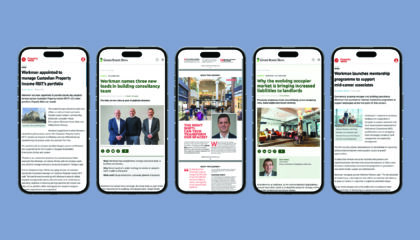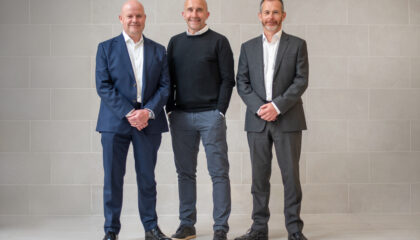Last week, our Richard Taylor, Partner and Head of Building Consultancy, joined a panel of office retrofit experts at Battersea Power Station’s 50 Electric Boulevard for Bisnow’s UK Office Series: The Renaissance, to share best practice on revitalising office spaces through upgrades.
During the panel: “Outlook on Upgrades: Making the Future Retro(Fitted)” Richard (pictured above, far right) pointed out that a key driver for retrofitting buildings was not only energy efficiency in itself, but also occupiers’ search for talent, where many Gen Z candidates are now asking potential employers on their sustainability and social impact credentials.
Richard explained that the only way to precisely gauge whether to redevelop or retrofit is to assess embodied carbon, and to monitor exactly how any given building is performing.
“Our whole-life carbon assessment experts are carrying out these assessments for our clients, based on the markets in which they are operating. We’ve already talked about how embodied carbon is one aspect, but what we also need is the data on how much energy the building is using,” Richard said.
Optimising the office retrofit with tech
A solution, he says, is to bring occupiers along on the energy efficiency journey by installing building tech to give occupiers clarity.
“We then tend to find more collaboration on the operational side of things,” he said.
Richard went on to highlight Workman’s IBOS (intelligent building operating system), which has been shown to achieve up to 30% improvement in efficiency by optimising the existing building’s M&E plant.
If office retrofits generally come in around £200 to £500 per sq. ft, there’s a level below that, particularly in the regions, he explained, where it’s not only possible to reuse M&E kit, but also to make that same kit much more efficient.
“By targeting low-hanging fruit, IBOS can give very quick payback, and often makes seemingly very inefficient M&E systems significantly more efficient,” Richard said. “And that knowledge in itself, enables certain schemes to become viable.”
“Technology is key: it’s key for potentially cutting cost on the way in. It’s certainly key for educating occupiers and investors during the operation of the building. But on the liquidity side, it provides a very robust set of empirical data, which shows how well the building is operating now, and how efficient it is compared to the market average. It is a useful bit of information to include in the sales pack,” Richard said.
Richard’s panel also featured insight from Ben Gillam, CEO and Founder, Thirdway; Isabel Thomas, Head of Offices, Shaftesbury Capital PLC; Fergus Evans, Office Portfolio Direct, Grosvenor; Robin Pritchett, Head of Building Performance UK Cundall; with Adam Carney, Legal Director at Pinsent Masons, as moderator for the group.
Read more about the event here: UK Office Series: The Renaissance in London (bisnow.com)
Find out more about Workman’s retrofit toolkit here: What’s in the 2024 retrofit toolkit? | Workman











